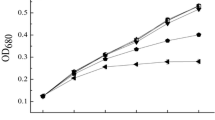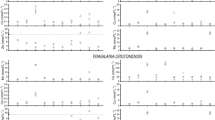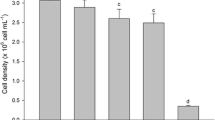Abstract
Comparative studies were carried out on the adsorption of copper by a range of laboratory-cultured algae and freshwater phytoplankton samples. The level of surface mucilage associated with the cultured algae ranged from high (Anabaena spiroides, Eudorina elegans) to moderate (Anabaena cylindrica, Microcystis aeruginosa) to complete absence (Chlorella vulgaris, Asterionella formosa, Aulacoseira varians, Ceratium hirundinella). With laboratory cultures, the rapid uptake, EDTA release and quantitative similarity between living and dead (glutaraldehyde-fixed) algae were consistent with physical binding of Cu at the cell surface. The higher Cu adsorption per unit surface area and longer adsorption time of mucilaginous algae in the time-course study, and the relatively high level of Cu bound to mucilage found by X-ray microanalysis suggest that mucilage played an important role in metal binding. For all species examined, Cu adsorption kinetics (external Cu concentrations 1 to 1000 mg L−1) showed a clear fit to the Freundlich, but not the Langmuir isotherm, indicating a monolayer adsorption model with heterogenous binding sites. The Freundlich adsorption capacity constant (Kf) was higher in mucilaginous (3.96–12.62) compared to nonmucilaginous (0.36–3.63) species, but binding intensity (Freundlich constant 1/n) did not differ between the two cell types. The results suggest that mucilaginous algal species may have potential as biosorbents for treatment of industrial effluents containing heavy metals. Investigation of the Cu adsorption behavior of four mixed phytoplankton samples also revealed a good fit to the Freundlich, but not the Langmuir, isotherm. Freundlich constants were in the range 2.3–3.2 for samples dominated by Chlorophyta, Bacillariophyta and Cyanophyta, but recorded a value of 7.4 in the sample dominated by Dinophyta. Comparison with data from laboratory monocultures suggested that the adsorption kinetics of mixed environmental phytoplankton samples cannot be predicted simply in terms of the major algal species.
Similar content being viewed by others
References
Adamson AW (1967) Physical chemistry of surfaces, 2nd ed., Interscience Publishers, New York.
Bellinger EG (1974) A note on the use of algal sizes in estimates of population standing crops. Br. Phycol. J. 9: 157–161.
Booth KN (1988) The Occurrence and Elemental Composition of Phytoplankton and Bacteria in Rostherne Mere, Cheshire, PhD Thesis, University of Manchester, UK.
Cho D-Y, Lee S-T, Park S-W, Chung A-S (1994) Studies on the biosorption of heavy metals onto Chlorella vulgaris. J. Environ. Sci. Health A 29: 389–409.
Darnall DW, Greene B, Hosea M, Mcpherson RA, Henzl M, Alexander MD (1986) Recovery of heavy metals by immobilized algae. In Thompson R (ed), Trace Metal Removal From Aqueous Solution, The Royal Society of Chemistry Burlington House, London, pp. 1–24.
De Philippis R, Paperi R, Sili C, Vincenzini M (2003) Assessment of the metal removal capability of two capsulated cyanobacteria, Cyanospira capsulata and Nostoc PCC7936. J. Appl. Phycol. 15: 155–161.
De Philippis R, Sili C, Paperi R, Vincenzini M (2001) Exopolysaccharide-producing cyanobacteria and their possible exploitation: A review. J. Appl. Phycol. 13: 293–299.
De Rome L, Gadd GM (1987) Copper adsorption by Rhizopus arrhizus, Cladosporium resinae and Penicillium italicum. Appl. Microbiol. Biotechnol. 26: 84–90.
Fehrmann C, Pohl P (1993) Cadmium adsorption by the non-living biomass of microalgae grown in axenic mass culture. J. Appl. Phycol. 5: 555–562.
Förstner U, Wittmann GTW (1981) Metal pollution in the aquatic environment, Springer-Verlag, Berlin.
Freundlich H (1926) Colloid and capillary chemistry, Methuen, London.
Glooschenko WA (1969) Accumulation of 203Hg by the marine diatom Chaetoceros costatum. J. Phycol. 5: 224–226.
Greene B, Darnall DW (1990) Microbial oxygenic photoautotrophs (Cyanobacteria and algae) for metal binding. In Ehrlich M, Brierley CL (eds), Microbial Mineral Recovery, McGraw-Hill, New York, pp. 277–302.
Harris PO, Ramelow GJ (1990) Binding of metal ions by particulate biomass derived from Chlorella vulgaris and Scenedesmus quadricauda. Environ. Sci. Technol. 24: 220–228.
He LM, Tebo BM (1998) Surface charge properties of Cu(II) adsorption by spores of the marine Bacillus sp. Strain SG-1. Appl. Environ. Microbiol. 64: 1123–1129.
Holan ZR, Volesky B, Prasetyo I (1993) Biosorption of cadmium by biomass of marine algae. Biotechnol. Bioeng. 41: 819–825.
Khummongkol D, Canterford GS, Fryer C (1982) Accumulation of heavy metals in unicellular algae. Biotechnol. Bioeng. 14: 2643–2660.
Kiefer E, Sigg L, Schosseler P (1997) Chemical and spectroscopic characterization of algae surfaces. Environ. Sci. Technol. 31: 759–764.
Langmuir I (1918) The adsorption of gases on plane surfaces of glass, mica and platinum. J. Am. Chem. Soc. 40: 1361.
Lee RE (1997) Phycology, 2nd ed., Cambridge University Press, Cambridge.
Leppard GG (1995) The characterisation of algal and microbial mucilages and their aggregates in aquatic systems. Sci. Total Environ. 165: 103–131.
Li P, Liu Z, Xu R (2001) Chemical characterization of the released polysaccharide from the cyanobaterium Aphanothece halophytica GR02. J. Appl. Phycol. 13: 71–77.
Mcknight DM, Morel FMM (1979) Release of weak and strong copper-complexing agents by algae. Limnol. Oceanogr. 24: 823–837.
Mullen MD, Wolf DC, Beveridge TJ, Bailey GW (1992) Sorption of heavy metals by the soil fungi Aspergillus nigerand Mucor rouxii. Soil Biol. Biochem. 24: 129–135.
Mullen MD, Wolf DC, Ferris FG, Beveridge TJ, Flemming CA, Bailey GW (1989) Bacterial sorption of heavy metals. Appl. Environ. Microbiol. 55: 3143–3149.
Özer D, Aksu Z, Kutsal T, Caglar A (1994) Adsorption isotherms of lead(II) and chromium(VI) on Cladophora crispate. Environ. Technol. 15: 439–448.
Parker DL, Mihalick JE, Plude JL, Plude MJ, Clark TP, Egan L, Flom JJ, Rai LC, Kumar HD (2000) Sorption of metals by extracellular polymers from the cyanobacterium Microcystis aeruginosa f. flos-aquae strain C3-40. J. Appl. Phycol. 12: 219–224.
Parker DL, Rai LC, Mallick N, Rai PK, Kumar HD (1998) Effects of cellular metabolism and viability on metal ion accumulation by cultured biomass from a bloom of the cyanobacterium Microcystis aeruginosa. Appl. Environ. Microbiol. 64: 1545–1547.
Pistocchi R, Mormile AM, Guerrine F, Isani G, Boni L (2000) Increased production of extra- and intracellular metal-ligands in phytoplankton exposed to copper and cadmium. J. Appl. Phycol. 12: 469–477.
Radway JC, Wilde EW, Whitaker MJ, Weissman JC (2001) Screen of algal strains for metal removal capabilities. J. Appl. Phycol. 13: 451–455.
Reynolds CS (1993) The ecology of freshwater phytoplankton, Cambridge University Press, Cambridge.
Scott JA, Sage GK, Palmer SJ (1988) Metal immobilisation by microbial capsular coatings. Biorecovery 1: 51–58.
Su M-C, Cha DK, Anderson PR (1995) Influence of selector technology on heavy metal removal by activated sludge: secondary effects of selector technology. Water Res. 29: 971–976.
Tien C-J (1999) Phytoplankton Mucilage – Quantification, Characterisation and Determination of Metal-binding Activity, PhD Thesis, Manchester University, UK.
Tien C-J (2002) Biosorption of metal ions by freshwater algae with different surface characteristics. Process Biochem. 38: 605–613.
Weber WJ (1972) Physicochemical processes for water quality control, Wiley-Interscience, New York.
Weckesser J, Hofmann K, Jürgens UJ, Whitton BA, Raffelsberger B (1988) Isolation and chemical analysis of the sheaths of the filamentous cyanobacteria Calothrix parietina and C. scopulorum. J. Gen. Microbiol. 134: 629–634.
Wehrheim B, Wettern M (1994) Biosorption of cadmium, copper and lead by isolated mother cell walls and whole cells of Chlorella fusca. Appl. Microbiol. Biotechnol. 41: 725–728.
Xue H-B, Stumm W, Sigg L (1988) The binding of heavy metals to algal surfaces. Water Res. 22: 917–926.
Zhang W, Majidi V (1994) Monitoring the cellular response of Stichococcus bacillaris to exposure of several different metals using in vivo 31P NMR and other spectroscopic techniques. Environ. Sci. Technol. 28: 1577–1581.
Zhou JL, Huang PL, Lin RG (1998) Sorption and desorption of Cu and Cd by macroalgae and microalgae. Environ. Pollut. 101: 67–75.
Zouboulis AI, Loukidou MX, Matis KA (2004) Biosorption of toxic metals from aqueous solutions by bacteria strains isolated from metal-polluted soils. Process Biochem. 39: 909–916.
Author information
Authors and Affiliations
Corresponding author
Rights and permissions
About this article
Cite this article
Tien, CJ., Sigee, D.C. & White, K.N. Copper adsorption kinetics of cultured algal cells and freshwater phytoplankton with emphasis on cell surface characteristics. J Appl Phycol 17, 379–389 (2005). https://doi.org/10.1007/s10811-005-5555-y
Received:
Revised:
Accepted:
Issue Date:
DOI: https://doi.org/10.1007/s10811-005-5555-y




